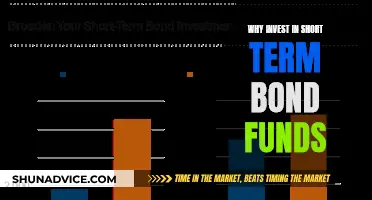
When you reinvest dividend income from a mutual fund investment, you are essentially using the cash dividends you receive to buy more shares of the same fund. This strategy, known as dividend reinvestment, is a great way for investors to steadily grow their wealth over time. By enrolling in an automatic dividend reinvestment program, investors can benefit from the power of compounding, where dividends are used to purchase additional shares, which then generate their own dividends, creating a snowball effect. While dividend reinvestment offers several advantages, such as convenience and commission-free transactions, it is important to consider factors like investment goals, risk tolerance, and tax implications before deciding whether to reinvest dividends or take the cash.
| Characteristics | Values |
|---|---|
| Advantages | Compounding, higher total returns, dollar-cost averaging, no trading fees, DRIP discounts, automatic, easy and convenient |
| Disadvantages | Lack of control over share price, outsized allocation to a particular stock, lack of diversification, share minimums, cash tied up, tax bill |
| When to reinvest | Long-term goals, buy-and-hold investor, long time horizon, bull market |
| When not to reinvest | Need income, need cash to reach a goal, want to diversify |
What You'll Learn

Compounding your investment's growth
Compounding your investments growth
Compounding is a powerful wealth-building strategy that involves reinvesting your investment profits to generate even more profits over time. By reinvesting your dividend income from a mutual fund investment, you can achieve higher total returns and build your wealth steadily over the long term. Here's how compounding works and why it's beneficial for your investments:
- Dollar-Cost Averaging: When you reinvest your dividend income, you are buying more shares of the fund at varying prices over time. This strategy, known as dollar-cost averaging, helps to smooth out the impact of market fluctuations. By investing a fixed amount regularly, you purchase more shares when prices are low and fewer shares when prices are high, reducing the overall average cost per share.
- Snowball Effect: As you reinvest your dividends, the additional shares you purchase will also generate dividends. Over time, these dividends can be reinvested to buy even more shares, creating a snowball effect. This compounding effect can lead to exponential growth in your investment portfolio.
- Long-Term Growth: Compounding allows your investment to grow quietly and steadily over an extended period. When you reinvest your dividends, you are giving up immediate income for the potential of much higher returns in the future. This strategy is particularly effective for long-term investment goals, such as retirement planning.
- Automatic Wealth Building: Many mutual funds offer automatic dividend reinvestment plans, known as Dividend Reinvestment Plans (DRIPs). With a DRIP, your dividends are automatically used to purchase additional shares without any action required on your part. This ensures that your dividends are consistently reinvested, allowing you to take full advantage of compounding.
- Tax Benefits: Reinvesting your dividends can also provide tax benefits. When you reinvest your dividends, you increase your investment's cost basis over time. As a result, when you eventually sell your shares, your cost basis will be higher, potentially lowering your capital gains taxes.
- Convenience and Cost Savings: Setting up a dividend reinvestment plan is usually straightforward and can be done through your brokerage account or directly with the mutual fund company. Dividend reinvestment is often commission-free, and some companies even offer discounted share prices for investors who participate in DRIPs.
However, it's important to consider the potential drawbacks of compounding through dividend reinvestment:
- Lack of Control: When reinvesting dividends, you may have limited control over the price at which you buy additional shares. If the share price increases significantly, you will still purchase shares at a higher price.
- Overconcentration: Reinvesting dividends in the same fund may lead to an overconcentration of your portfolio in a particular investment. This lack of diversification can increase your risk if the fund underperforms or experiences volatility.
- Cash Flow Constraints: By reinvesting your dividends, you give up immediate cash flow that could be used for other purposes, such as funding immediate financial needs or diversifying your investments.
In summary, compounding your investment growth through dividend reinvestment can be a powerful strategy for building wealth over the long term. It allows you to take advantage of dollar-cost averaging, the snowball effect of compounding, and the convenience of automatic reinvestment plans. However, it's important to carefully consider your investment goals, risk tolerance, and time horizon before deciding whether to reinvest your dividends or take the cash payout.
Class C Mutual Funds: When to Invest and Why
You may want to see also

Dollar-cost averaging
With DCA, investors commit to making regular contributions to their investment account, regardless of the market price of the asset. This approach has several benefits:
- Low Barrier to Entry: DCA allows investors to start investing with a small amount of money and does not require a large sum of money upfront.
- Flexibility: Investors can invest as little or as much as they want, as long as they maintain consistent contributions.
- Accessibility: DCA provides greater access to investing for low-income workers or students who may not have a large amount of money to invest.
- Long-Term Gains: DCA helps neutralize temporary volatility in the markets and focuses on long-term gains.
- Saving Habit: DCA encourages investors to save regularly, especially for retirement.
When reinvesting dividend income from a mutual fund investment using DCA, investors use the dividend income to purchase additional shares of the fund at regular intervals. This approach has the advantage of compounding distributions over time, which can lead to exponential growth in the investment portfolio.
By reinvesting dividends, investors are giving up income now for the potential of higher income in the future. The dividend income is used to buy more shares of the fund, increasing the investor's stake over time. This strategy is particularly attractive to individual retirement account holders who want to avoid the tax penalty of taking dividends early.
Additionally, reinvesting dividends in a mutual fund can provide the benefits of compounding. As the fund's share price appreciates, the value of the reinvested dividends also grows, contributing to overall returns. Many dividend-producing mutual funds offer automatic dividend reinvestment plans (DRIPs), which ensure that dividends are consistently reinvested, maximizing the benefits of compounding.
In summary, dollar-cost averaging is a powerful strategy for investors who want to grow their investment portfolios over time, especially for those reinvesting dividend income from mutual funds. By making regular contributions and purchasing additional shares at consistent intervals, investors can benefit from long-term gains, neutralize market volatility, and build their investment portfolios.
Best Vanguard Funds to Maximize Your 401(k) Returns
You may want to see also

Automatic dividend reinvestment plans
DRIPs are offered by brokerage firms, mutual fund companies, and public companies. They are available for various investment vehicles, including mutual funds and employee stock options.
There are two main types of DRIPs: brokerage account plans and company DRIPs. Brokerage account plans allow investors to access multiple investment types, such as individual stocks, mutual funds, and ETFs, from a single account. They also make it easier to diversify holdings and provide consolidated investment statements. However, not all brokers offer fractional shares.
Company DRIPs, on the other hand, allow investors to purchase stock by reinvesting dividends, often on a fractional basis. Some companies even offer their stock at a discount to the market price. However, company DRIPs may follow their own schedules for investing, and there may be enrollment and other fees. Managing multiple company DRIPs can also entail more paperwork than holding a single brokerage account.
Regardless of the type of DRIP, reinvesting dividends is a powerful way to boost long-term returns and take advantage of compounding.
Mutual Fund Investment: Key Factors to Consider
You may want to see also

Tax implications
The tax implications of reinvesting dividend income from a mutual fund investment can be complex and depend on various factors, including the type of dividend and the investor's location. Here is a detailed overview of the tax implications:
- Taxation of Dividends: In general, dividends are taxable, regardless of whether they are reinvested or received as cash payouts. The Internal Revenue Service (IRS) considers dividends as taxable income, and you will incur a tax liability in the year the dividends are reinvested.
- Qualified vs. Ordinary Dividends: Dividends fall into two categories for tax purposes: qualified and non-qualified (also called ordinary). Qualified dividends are taxed at lower long-term capital gains rates and must meet specific IRS holding period requirements. Ordinary dividends, on the other hand, are taxed as ordinary income at the marginal tax rate.
- Reporting Reinvested Dividends: Both qualified and non-qualified reinvested dividends must be reported on your tax return. Your brokerage will typically send you Form 1099-DIV, which details your dividend income for the year and categorizes it as ordinary or qualified dividends. You then report these amounts on your Form 1040, with qualified dividends reported on line 3a and non-qualified dividends on line 3b.
- Retirement Accounts: While you cannot entirely avoid taxes on reinvested dividends, you can defer paying taxes on them by holding the dividend-paying securities in a tax-deferred retirement account such as a 401(k) or IRA. Contributions to these accounts may be tax-deductible, allowing your dividend reinvestments to grow tax-free until withdrawal in retirement.
- Taxes on Sale of Securities: When you sell securities that have previously reinvested dividends, you must pay taxes on any gains. The tax rate depends on how long you held the stock and whether the dividends are qualified or ordinary.
- Automatic Reinvestment Plans: Many mutual funds offer automatic dividend reinvestment plans (DRIPs). While these plans provide the benefit of consistent reinvestment, the taxes on reinvested dividends still apply, and you must report them accordingly.
- Dividend Reinvestment vs. Growth Funds: When deciding between reinvesting dividends and investing in growth funds, consider the tax implications. Reinvested dividends may offer tax benefits by increasing your investment's cost basis over time, potentially resulting in lower taxes when you sell your shares. Growth funds, on the other hand, may produce capital gains when you sell shares for a profit, and these gains are taxed accordingly.
- Consult a Professional: Given the complexity of tax laws and the specific circumstances of each investor, it is always advisable to consult a tax professional or financial advisor to fully understand the tax implications of reinvesting dividend income from mutual funds.
College Fund: When to Shift to Safer Investments?
You may want to see also

DRIPs (Dividend Reinvestment Plans)
Dividend Reinvestment Plans (DRIPs) are a great tool for long-term investors. They are a formal program offered by a publicly traded corporation to existing shareholders. A DRIP allows investors to reinvest their cash dividends into additional shares or fractional shares of the underlying stock on the dividend payment date.
DRIPs are a great way to ensure your money is working as hard as possible for you. They are a form of dollar-cost averaging, which helps smooth out the impact of market fluctuations. This is a strategy in which you invest consistently in the market over time, no matter the share prices.
DRIPs are often the most cost-effective and efficient means of compounding your wealth. They are usually commission-free and allow for fractional shares. This means that all of your money is constantly working for you and growing exponentially over time instead of sitting idly in cash.
DRIPs also offer discounted share prices, typically between 1% and 10%. This can be a powerful way to generate much stronger returns over time without the risks that come with traditional methods of boosting returns, such as leverage.
DRIPs are easy to set up. Most major brokers make enrollment simple and charge little to no commission. Once enrolled, the process is entirely automated and requires minimal attention or monitoring.
There are three ways to get involved in DRIPs: directly through the company, through your broker, or through a transfer agent. Company-run DRIPs are generally only available through large, blue-chip dividend stocks. That's because smaller companies don't want to take on the overhead costs of tracking all their shareholders and handling the paperwork.
DRIPs are a great option for investors who don't need current income and are happy to put their investment portfolios on auto-pilot.
Blackstone's Borrowed Funds: A Strategic Investment Move
You may want to see also
Frequently asked questions
Dividend reinvestment is using the cash dividend paid by a company or fund to buy more shares of the same investment.
Dividend reinvestment is a simple process. When a company pays dividend income, the broker or company uses the cash to buy more shares of the underlying investment, which is completely automated if an investor signs up for automatic dividend reinvestment or a DRIP (Dividend Reinvestment Plan) program.
Pros:
- Compounding earnings: Dividend reinvestment allows you to buy more shares and build wealth over time.
- Lower risk: You can take advantage of dollar-cost averaging, which limits the inherent risks of timing the market.
- Easy and convenient: The process is automatic and continues until you opt out.
- No trading fees: Dividend reinvestment is usually commission-free.
- DRIP discounts: Some companies offer discounts on DRIP shares, giving you a better price than you could get on the open market.
Cons:
- Limit diversification: When you reinvest your dividends in a company you already own, your portfolio can become unbalanced.
- Share minimums: Some companies have minimum share requirements to participate in a DRIP.
- Cash is tied up: You miss out on cash you could spend, save, or invest elsewhere.
- Tax liability: Dividends are taxed whether you take a cash payout or reinvest them.







